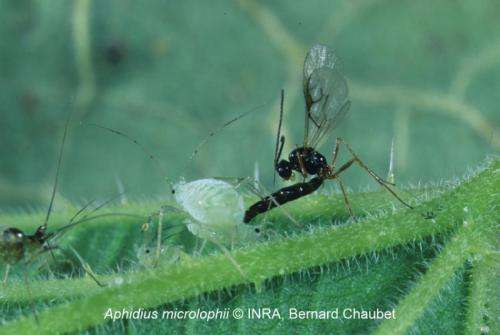Exploring the natural enemies of insect pests

A method of investigating whether aphid pests have been targeted by their gruesome enemies could shed new light on how farmland organisms interact, and potentially help protect important food crops.
Aphids are capable of causing considerable damage to crops by sucking out the sweet sap, stunting growth and reducing yields. In some crops they also spread disease amongst plants, which can be even more destructive than their feeding behaviour. Farmers may spray their crops with costly insecticides several times a year to help reduce aphid numbers. However, scientists at the University of Hull are examining the beneficial role played by the natural enemies of these pests.
Dr Stéphane Derocles, Post-Doctoral Research Associate in the University of Hull's Network Ecology Group, is one of the first to take a new approach to this field of research. The results of his study, published in the journal Molecular Ecology, shed light on the particularly grisly relationship between aphids and parasitic wasps.
Dr Derocles said: "In the past, the only way to identify whether an aphid was harbouring a parasitoid was to collect the aphids in the field, rear them in the lab and then observe if an adult wasp emerged. Identifying the precise species of wasp involved was exceptionally difficult, as they are tiny and appear very similar.
"Now we have a revolutionary new molecular technique that can not only tell us whether or not an aphid has a parasitoid, but also which species of parasitoid the aphid contains."
Female parasitic wasps lay their eggs inside aphids, and then the developing parasitoid larva eats the host alive, before finally emerging from the dead aphid as an adult wasp. The larvae are 'parasitoids' and not 'parasites', because they always kill the aphid rather than just living inside it. Aphids which have died in this way appear swollen and brown with a papery appearance, and are known as 'mummies'.
During his PhD in France, supervised by Professors Anne Le Ralec and Manuel Plantegenest at the 'Agrocampus Ouest' research institute, Dr Derocles collected more than 530 aphids from field crops, and a further 2,097 aphids from field margins (the strips of grass and wildflowers found around the edges of fields). He was interested to see if the field margins acted as a 'reservoir' for the beneficial parasitoids; therefore helping to control aphid numbers in the crop.
He said: "We collected the aphids individually in tubes and then extracted the DNA. By targeting a short region of DNA specific to the parasitoid wasp, we were able to see which aphids were carrying a parasitoid, and which were parasitoid-free.
"Taking this a step further, when we did find parasitoid DNA we were able to look at the sequence in detail, and in the majority of cases we were able to identify the precise species of parasitoid that had been living in the aphid."
Dr Derocles' research shows that the relationship between aphids and parasitoids is much tighter than previously envisaged.
He added: "The overall proportion of aphids carrying a parasitoid was 32%, with parasitism rates much higher in the field margins than in the crops. However, we found that each species of aphid tended to be associated with its own species of parasitoid, and there was very little mixing between the aphids and parasitoids found in the margins, and the aphids and parasitoids found in the crops."
Dr Derocles found only three (out of at least 32) species of parasitoid that were targeting aphids in both crops and field margins. It would appear that, in this experiment at least, field margins were contributing little to the biological control of aphid pests. However, these habitats are known to be important for predators of other farmland pests as well as for insect pollinators.
For scientists studying biological methods of pest control, understanding how farmland plants, pollinators, insect pests and their parasitoids interact is an important issue.
Dr Darren Evans, Senior Lecturer in Conservation Biology at the University of Hull, and co-author of the study explained why.
He said: "All organisms are linked to at least one other species in a variety of ways, and unless we learn more about these networks of interactions, it's impossible to know how our farmland ecosystems might change in the future.
"In particular, we need to increase our understanding of how climate change might impact our farmland species, and as a result of that, the UK farmland economy. As part of the University's Energy and Environment research theme, we are now working with the Centre for Adaptive Science and Sustainability (CASS) and Hull University Business School (HUBS), to address this important issue."
More information: Derocles, A., Ralec, A., Besson, M., Maret, M., Walton, A., Evans, D. and Plantegenest, M. 2014. Molecular analysis reveals high compartmentalisation in aphid-pimary parasitoid networks and low parasitoid sharing between crop and non-crop habitats. Molecular Ecology. onlinelibrary.wiley.com/doi/10 … 1/mec.12701/abstract
Journal information: Molecular Ecology
Provided by University of Hull















